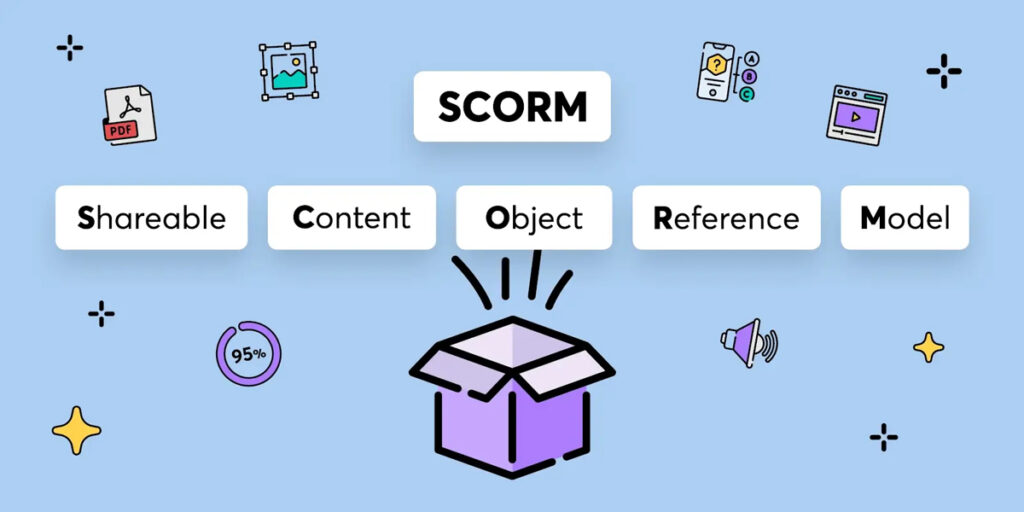As the e-learning industry continues to grow, there is a broader range of authoring tools and learning management systems for e-learning content creators to choose from and more courses for students to invest in themselves.
This can only be a good thing, right?
In essence, yes. More choice means companies creating e-learning courses and modules can take advantage of competitive prices. And with more courses on the market, anybody has the option to expand their knowledge and skills. However, the multitude of platforms and packages are not always compatible.
To get their course out to more people, e-learning content creators are often limited to the audience they can reach. The alternative option is to rewrite the same course for each platform. But that’s time-consuming and in most cases, will not be cost-effective.
The solution to this problem was the introduction of SCORM, a computer script that delivers universal standards that are compatible with modern devices. The program essentially enables content to be shared across various tools and platforms.
In short, SCORM improves the functionality involved in distributing e-learning content and enables tutors/trainers to track input data presented by students/trainees.
What is SCORM?
SCORM is a set of technical specifications that provide a universal approach to e-learning content. The plug ’n’ play solution ensures there is an industry-standard that clients and businesses can trust regardless of the authoring tool or Learning Machine System (LMS) they want to use.
The key benefit of SCORM is that it gives users the ability to create an online course which can be shared across multiple platforms. This means you only need to create the course once but can reach a wider audience.
SCORM is an acronym that can be employed to help content creators put online e-learning courses together.
S = Shareable
C = Content
O = Object
R = Reference
M = Model
The process of SCORM actually breaks the acronym down into two parts. Shareable Content Object (SCO) ensures that elements of any SCORM (the content package/e-learning material) can be used across multiple platforms and learning management systems.
Reference Model applies to the fact that SCORM is also a standard that must be reached by e-learning courses. The standards can be thought of as the rules that the industry must follow.
What are the Different Types of SCORM?
Technically, there are five versions of SCORM but only two are widely used today; versions 1.2 and 2004 (formerly known as 1.3). The latest version (2004 4th edition) extends and formalises the packaging and includes a Run-Time Environment book that eliminated some features that were deemed surplus to requirements on 1.2.
Although some users still operate with version 1.2, the new 2004 version features upgrades that are invaluable to today’s e-learning environments. The most notable inclusion is Sequencing and Navigation feature which facilitates the creation of richer content and registers the end-users interaction with the course.
A seamless scoring system and the ability to set boundaries for passing tests are invaluable tools for teachers which gives it an advantage over earlier versions.
But the latest version earns its bacon because it provides more stability across different devices. This is important given a huge number of people consume e-learning content on mobile devices that may not always have access to a stable network connection.
How To Implement SCORM?
If you’re planning to invest in an LMS, the best option is to choose one that is already SCORM compliant. If your existing LMS does not support the latest version of SCORM, you will need to fasten the technical nuts and bolts to it before you can share your content across various platforms.
Whereas SCORM conformance is fairly painless, LMS conformance requires input from a talented software developer. SCORM is usually used by creating e-learning content in software that specifically creates SCORM-compliant files such as HTML.
Sliced Bread has created a number of e-learning modules for global companies, training employees on everything from company values and leadership training to health and safety and how to manage staff. To ensure the e-learning package works across various platforms, we use Articulates Storyline and use SCORM standards to assure our clients that the modules we create can be shared with anybody.
In order to make the implementation process as smooth as possible, we save the content onto a ZIP file – which is how SCORM-compliant content is usually delivered. The ZIP file can be used in any LMS and the content is easy to transfer.
Further reading
To find out more about the benefits of scenario training, see our blogpost on Scenario Based E-learning Is An Efficient And Engaging Way To Learn here.
Do you need to develop scenario based e-learning either via Articulate Storyline, Augmented Reality or Virtual Reality? Why not drop us an email at info@sbanimation.com, or give us a call on +44 (0)207 148 0526. We would be happy to help.
We also post industry related content to our LinkedIn company page, why not give us a follow?









